Slip Ring FAQs

Frequently Asked Questions About Slip Rings
Q: What's the difference in wear between different brush materials?
A: Many slip rings incorporate sacrificial brushes that wear and shed debris, spreading contaminates in the unit. Our patented fiber brushes produce virtually no debris - eliminating downtime to change brushes and protecting the unit from debris contamination.
Q: Your brochures highlight your ability to pass signals through your slip rings. Don't most slip rings pass signals? How are yours different in that respect?
A: The most basic slip ring design can pass power. We can handle audio, video, DC power, AC power, temperature sensors, heaters, high voltage, strain gauges, digital data and control signals to name a few. Successfully passing high speed requires a much more sophisticated design than just transmitting power. Moog slip rings successfully transmit the broadest band frequency transmission - from DC to gigahertz - with absolute data integrity.
Q: When would I use slip ring separates, as opposed to a capsule?
A: A separate can sometimes accommodate size constraints better than a capsule. It also allows you to mate the rotor and stator in your own system, if you desire. Our slip ring engineers can offer their years of expertise to you as you decide which approach is better for your design.
Q: It sounds like a slip ring is a neat solution in a lot of designs, but I need a device for limited, not continuous, rotation. What is my alternative?
A: Slip rings work just as well in an oscillating or scanning mode as they do in continuous rotation. As a matter of fact, this type of limited oscillating motion is probably more common than continuous rotation. Moog slip rings are designed to work with rotation in either direction and perform just as well in an oscillating mode as in continuous mode. In special cases when very low amplitude, high frequency oscillation or dither, is required for long durations, a Moog application engineer should be consulted.
Q: A slip ring seems to be called a lot of different names - rotary electrical interface, commutator, collector, swivel and rotary joint are a few that I've heard. If they're all the same thing, why are so many names used? I wish you guys would make up your minds - it's confusing!
A: Alas, you are correct. And it is confusing. We've consistently called them slip rings for the 60 years that we've been designing and manufacturing them. We've noted that some other slip ring manufacturers, technical and industrial publications and engineering textbooks sometimes use other names. Our goal is that with consistent repetition, slip ring will become the standard term for the device.
Q: Can slip rings really accommodate the dust and splashes inherent in real life usage?
A: Most of our commercial slip rings are available with an optional seal that protects them from dust and splashes. They cannot, however, be immersed in water. If a unit is going to be subjected to wash downs, the slip ring is usually enclosed in a protective housing.
Q: In slip ring terminology, how is a "circuit" defined?
A: Confusion has arisen because different industries define the term in different manners. We refer to a circuit as a single conducting path through the slip ring. If there is a return path or ground, that is a separate circuit. Circuit, ring and way are synonymous.
Q: Why should I choose precious metal over mercury contacts?
A: The primary reason is safety. Mercury is, of course, a toxic substance, so if your application involves food manufacturing or processing, pharmaceutical equipment or any other use where contamination could be a serious threat, your choice should be precious metal contacts. Leakage of the mercury and the resultant contamination could be extremely serious.
Q: Slip rings come in a lot of different shapes and sizes. Is there a performance difference between pancake and drum shape?
A: Although we've designed some excellent pancake slip rings, our expertise has shown that a drum design is more cost effective and performs better than a pancake design. A pancake slip ring usually has greater weight and volume for the same circuits, greater capacitance and crosstalk, greater brush wear and more readily collects wear debris on its vertical axis. However, a pancake offers reduced axial length for the number of circuits. So the decision to use a pancake is usually due to the size and shape of the envelope with which you're working.
